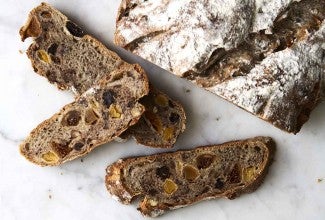-
The flour/liquid ratio is important in this recipe, so measure carefully. Your best bet is to weigh the flour; or measure it by gently spooning it into a cup, then sweeping off any excess.
-
Combine all the ingredients in a large mixing bowl.
-
Mix everything together using a bowl scraper or spatula. Once you’ve made a shaggy, cohesive dough, run the scraper or spatula down the inside far wall of the bowl, bring the dough up from the bottom of the bowl, and fold it over on top of itself. Quickly repeat 20 to 25 times, rotating the bowl with each stroke so you’re always working on a different portion of the dough.
-
Cover the bowl and let the dough rise (ferment) for 3 hours. Every 30 minutes repeat the “folding” process described above, giving the dough about 20 to 25 strokes each time.
-
To make baguettes, divide the dough into seven pieces, about 247g each. To make freestanding round loaves (boules) or 9” x 5” loaves, divide the dough into three pieces, about 578g each. To make rolls or hamburger buns, divide the dough into 1 1/2 dozen pieces, about 96g each. Note: You can mix and match any of these shapes; see "tips," below.
-
Gently round the pieces into balls and let rest, covered, on a lightly floured surface for about 20 minutes; this gives the dough a chance to relax.
-
After 20 minutes, shape the pieces into long, thin baguettes; round or pan loaves, or rolls as desired. If baking on a stone, place the baguettes or loaves onto parchment, for easiest transport. Place rolls on a parchment-lined or lightly greased baking sheet. Cover and let rise for about 1 hour, until noticeably puffy.
-
Preheat the oven to 500°F while the bread rises. If you're using a baking stone, position it on a middle rack while the oven preheats. Place an oven-safe shallow metal or cast-iron pan on the lowest oven rack, and have 1 cup of hot water ready to go.
-
When you're ready to bake, use a sharp knife or lame to slash the baguettes four or five times; the loaves, two or three times; or the rolls once. Make the cuts about 1/4" deep. The bread may deflate a bit when you slash it; that's OK, it’ll pick right up in the hot oven.
-
Place the bread in the oven — onto the baking stone, if you're using one, or simply onto a middle rack, if it's on a pan — and pour the 1 cup hot water into the shallow pan on the rack beneath. Be careful; the water will bubble and steam. Close the oven door quickly.
-
Bake baguettes for 22 to 25 minutes; boules or 9" x 5" loaves for 30 minutes, and rolls for 18 to 20 minutes. Bread will be a deep golden brown when done, and will sound hollow when thumped on the bottom. Check the bread 15 to 20 minutes into the baking time; if it’s darkening too quickly, lower the oven temperature to 450°F.
-
Remove the bread from the oven and cool on a rack. Store bread, securely wrapped, at room temperature for a day or so; freeze for longer storage.


















